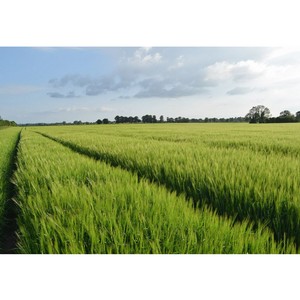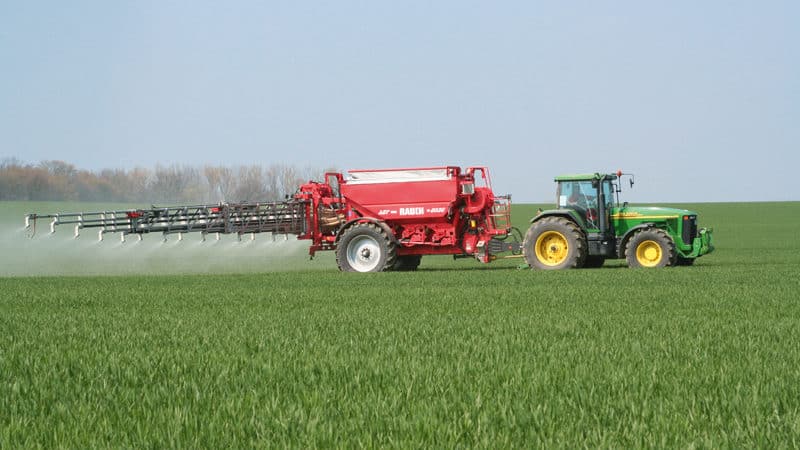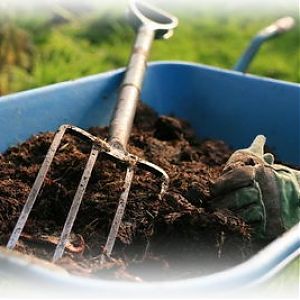Fertilizing winter wheat: methods and rates of fertilizer application
Winter wheat is gaining increasing popularity, as its yield is 30-45% higher than spring. The process of fertilizing winter wheat differs from traditional methods for spring plantings. If all recommendations are followed, not only does the yield of winter wheat increase, but also the quality of the product significantly improves.
Why do you need to fertilize winter wheat?
The growth of any wheat, including winter wheat, depends on the amount of fertilizer applied. Their insufficient quantity negatively affects productivity.
Winter wheat uses much more nutrients to produce a harvest than other crops. This is due to the fact that during ripening they move to the roots, but a certain amount remains in the aboveground part, which then dies.

The most important macroelements necessary for the full growth of winter wheat and obtaining 1 ton of harvest:
- calcium – 5 kg;
- magnesium – up to 5 kg;
- sulfur – 4 kg;
- iron – 250 g;
- boron – 8 g;
- zinc – 55 g;
- manganese – 80 g;
- copper – 8 g.
In nitrogen Wheat needs more nutrients than other nutrients. This substance is necessary for the production of protein in plant cells. With nitrogen deficiency, wheat leaves first turn light green and then turn yellow. Older leaves immediately turn brown and die.
Phosphorus plays an important role in energy transfer and storage in wheat.With a lack of this element, plant cell functions and the generation of new cells are reduced or stopped. With phosphorus deficiency, wheat is delayed in growth and development, the stem becomes thin, ears form late, the root system weakens, the leaves darken and decrease in size. The most obvious sign of phosphorus deficiency is the purple or reddish color of wheat leaves.
Potassium plays an important role in the process of photosynthesis and is involved in the regulation of cell turgor. A lack of potassium leads to the fact that the plant stem becomes weak, the leaves turn yellow and dry out, and the roots of new shoots do not develop.
Calcium necessary for wheat to ensure the growth of root hairs. In addition, it plays an important role in cell bonding. With a lack of calcium, the root system does not develop to normal, and the number of shoots decreases.
Magnesium participates in the process of photosynthesis and is necessary for the normal development of plant cells.
Sulfur – an integral part of the protein in the plant – is involved in the process of formation of new wheat cells. Signs of sulfur deficiency are similar to signs of nitrogen deficiency, but more pronounced.
Microelements such as iron, zinc, manganese, molybdenum, chlorine, boron also play an important role in the development of culture, although they are needed in smaller quantities. They participate in many processes occurring in plant cells, contribute to the formation of protein, and play a role in the formation of large molecules.
In case of iron deficiency and to prevent this condition, complex microfertilizers are applied to winter wheat during autumn and spring tillering - “Kelkat Mix Calcium” (0.5 kg/ha) or “Kelkat Fe” (0.2-0.3 kg/ha).
When to fertilize winter wheat

In order for winter wheat to produce a large harvest, it is fed with useful elements throughout the growing season:
- Fertilizing in autumn increases the winter hardiness of wheat. The best option is to introduce useful elements under plowing. In this case, all valuable substances end up in the soil at a depth of 20-25 cm, which has a good effect on the development of the root system.
- In early spring. Thanks to this feeding, the stem and spike core grow better.
- At the very beginning of the plant emerging into the tube. This fertilizing is called productive, as it affects the amount of wheat harvest.
- High-quality feeding. It is added before grain formation begins. This feeding has a positive effect on the intensity of photosynthesis and the quality of the final product.
Fertilizer application rates
The rates for applying nutrients to winter wheat depend on the amount of the planned harvest.
For a yield of 10 c/ha, fertilize with the following amount of elements:
- nitrogen – 25-30 kg;
- phosphorus – 10-14 kg;
- potassium – 20-25 kg.
Also pay attention to the proportions of these elements. The ideal ratio is 1.5:1:1-2. If this ratio is not met, yields will decrease and grain quality will suffer. Spring wheat is fertilized in the same dosages.
Reference. There is a difference in feeding winter and spring wheat. Winter crops are sown in autumn, and spring crops in spring. Spring crops ripen in a shorter period of time than winter crops, so their daily requirement for nutrients is greater than that of winter crops.
How to choose fertilizer
When choosing fertilizer for winter wheat, maintain a balance of elements. Let's look at this in more detail.
Mineral fertilizers
Mineral fertilizers increase the yield of winter wheat.Experienced farmers use complex fertilizers containing the main nutrients - nitrogen, phosphorus and potassium. Such fertilizers are used before sowing wheat or directly during this procedure.
Potash
Potassium affects the nutritional properties of grain and increases its resistance to cold. The substance is distributed over the soil surface before sowing (30 kg/ha). Potassium salt or potassium chloride is often used as a top dressing.
The rate of use of potassium chloride when sowing winter wheat for plowing and plowing in non-chernozem regions is 0.5-1 c/ha, potassium salt is 0.75-1.5 c/ha.
Magnesium

Magnesium affects the oxygen saturation of cells and, accordingly, determines the quality of grain.
For the best effect, fertilizing is applied foliar. The source of this element is magnesium sulfate with a concentration of 16%.
Calcium
Calcium has a beneficial effect on plant growth and increases the crop's resistance to various diseases.
A lack of calcium leads to poor growth of the root system, which means the plant will not be able to fully absorb moisture from the soil and receive the necessary nutrition. Calcium nitrate is usually used to feed this element.
Phosphorus
Phosphorus is involved in photosynthesis, increases the frost resistance of the crop and improves resistance diseases. It is usually applied during seed placement. Double or simple superphosphate is used as a source of the element. Phosphate rock is also used.
Nitrogen
Nitrogen fertilizers are necessary for growing winter wheat. Sources of nitrogen for the plant are ammonium nitrate and urea (urea), the nitrogen content in the latter is about 46%.
How to properly apply urea to wheat? Plants are fed by root and foliar methods. For winter wheat urea is applied in parts, since in the fall the substance is quickly washed out of the soil. Be sure to provide nitrogen nutrition to plants during the flowering period and until wax ripeness.
To increase productivity it is enough to add 30-60 kg of urea per 1 ha, in order to accumulate protein in the grain - 100-120 kg per 1 ha. When applying fertilizing, the predecessors are taken into account - after the legumes, the amount of fertilizer is reduced.
KAS-32
KAS-32 is a liquid urea-ammonia mixture with a nitrogen content of 32%. When using UAN-32, wheat is provided with three forms of nitrogen at once - amide, ammonium and nitrate. This is the main advantage of this fertilizer over solid types of fertilizers.
Ammonium sulfate
This fertilizer stands out among nitrogen fertilizers due to its sulfur content. Ammonium sulfate shows good results when applied to winter wheat, since fertilizing has a long-lasting effect on the crop with minimal loss of the main substance.
Sulfur
Sulfur is one of the important elements for winter wheat, since if it is deficient, the effect of nitrogen is impossible. Such fertilizers are applied simultaneously with nitrogen fertilizers. Magnesium sulfate (sulfate concentration – 16%) or superphosphate (concentration – 24%) is used as a source of sulfur nutrition.
Organic fertilizers
Such fertilizers increase soil fertility and activate microbiological processes. The most common organic fertilizers are manure, peat, green manure, and wood ash.
How to make fertilizers for wheat with your own hands
All mineral fertilizers are chemical products that are manufactured in factories by professionals using protective equipment. Trying to make mineral fertilizers on your own is dangerous. Only mixing certain types of fertilizers in strict proportions is allowed.
The situation with organic fertilizers is different - they are not dangerous.
Manure

The most common organic fertilizer. It is used in fresh and rotted form, as part of compost. Slurry contains important elements such as nitrogen and potassium.
To prepare a complete fertilizer, the slurry is mixed with superphosphate. Mullein is prepared as follows: fresh manure is poured with water in a ratio of 1:5 and left for 10 days.
IL
Rich in nitrogen, phosphorus and potassium, so it is often used as a top dressing. The most favorable time for collecting sludge is when the water level in the reservoir is minimal.
To enhance the effect, the substance is mixed with organic or mineral fertilizers.
tree bark
Wood bark and sawdust are used in processed form with mineral additives. They are composted before use. The moisture content of the bark should be about 75%.
For 100 kg of bark add 0.9 kg of ammonium nitrate, 0.7 kg of urea, 2 kg of sodium nitrate, 0.2 kg of superphosphate, 1.5 kg of ammonium sulfate. Compost can be used after 6 months, so it should be prepared in advance.
Ash
Contains about 30 different microelements. It is used to reduce soil acidity. Ash obtained from burning petroleum products, plastics and polymers cannot be used as fertilizer.
It is not difficult to prepare fertilizer yourself by mixing organic and mineral fertilizers, but you should avoid combining substances that will harm the crop.
Important! Do not mix ammonium nitrate and ammonium sulfate with organic fertilizers such as manure, ash, and bird droppings.
How to apply fertilizers correctly
Depending on the form of fertilizer, the tools for applying it to the soil differ. For liquid mineral fertilizers, PZHU and OP-2000 are used. To apply fertilizers in the form of granules or powder - fertilizer seeder RTT-4.2A, NRU-0.5, 1-RMG-4.
To fertilize the soil with solid organic fertilizers, units such as ROU-5, PRT-10, RUN-15B are used. Liquid organic fertilizers are applied by RZhT-8, RZHU-3.6. When adding fertilizers to furrows, use MLG-1. Liquid fertilizers are sometimes sprayed using small aircraft.
To ensure adequate nutrition of winter wheat during the entire growth period, the following fertilizer application dates are adhered to:
- in the fall before sowing or simultaneously with sowing;
- early spring to stimulate growth;
- during the flowering period;
- during the piping period.
Basically, two methods of fertilizing the crop are used:
- root method - fertilizer is applied to the soil, and it is absorbed by the roots of the plant;
- foliar method - nutrients are applied to the foliage and stem.
The main feeding is root feeding, because a significant amount of nutrients enters through the root system. Foliar is used additionally.
Fertilizer application rules:
- granule diameter – no more than 5 mm;
- feeding humidity is within 1.5-15%;
- apply fertilizer evenly so that there are no untreated areas.
Fertilizers are applied in dry or diluted form.The use of dry fertilizers requires additional abundant watering after the procedure. When applying fertilizers by foliar method, the dry components are diluted with water and sprayed by spraying.
Reference. Some farmers fertilize the lake. wheat according to Buznitsky - by the root method using disc seeders. It allows you to reduce the loss of useful elements that occur with the surface method of feeding plants.
Conclusion
To obtain not only a rich harvest of winter wheat, but also high-quality grain, fertilizing is carried out four times during the growing season. To saturate grain with protein, it is important to correctly combine mineral fertilizers, combining the necessary microelements. You can make organic fertilizers yourself by preparing compost or slurry.